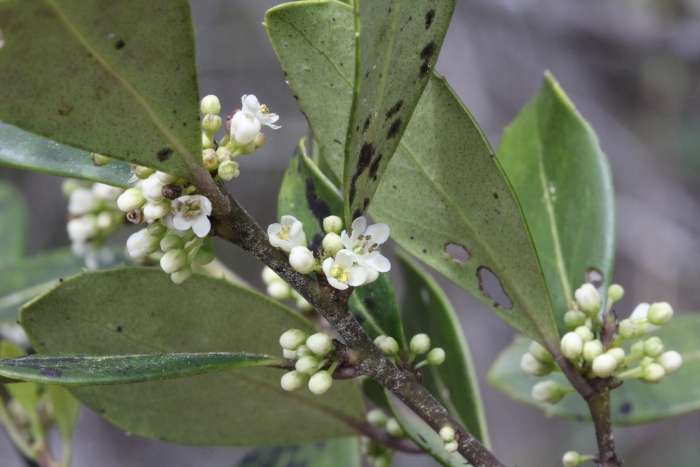Large Gallberry
(Ilex coriacea)
Large Gallberry (Ilex coriacea)
/
/

Samuel A. Schmid
CC BY 4.0
Image By:
Samuel A. Schmid
Recorded By:
Copyright:
CC BY 4.0
Copyright Notice:
Photo by: Samuel A. Schmid | License Type: CC BY 4.0 | License URL: http://creativecommons.org/licenses/by/4.0/ | Rights Holder: Samuel A. Schmid | Publisher: iNaturalist | Date Created: 2023-03-16T13:19:35-07:00 |





















Estimated Native Range
Summary
Ilex coriacea, commonly known as Large Gallberry or Sweet Gallberry, is an evergreen shrub native to the coastal plain wetlands, pine flatwoods, and pocosins of the Southeastern United States, ranging from Virginia to Texas. It typically grows to a height of 6-12 feet (1.8-3.6 meters) and a similar width, with a dense, rounded form. The shrub features small, inconspicuous white flowers in the spring, which are followed by black, berry-like drupes that persist into winter and are attractive to birds and wildlife.
Large Gallberry is valued for its ability to thrive in wet, acidic soils and its use in creating dense hedges or screens in landscape plantings. It is also appreciated for its low maintenance requirements and the fact that it provides year-round interest with its glossy, dark green foliage. In cultivation, it prefers partial to full shade and requires consistently moist soil conditions. While it is not commonly afflicted by serious pests or diseases, root rot can occur in poorly drained soils. This shrub is particularly useful in restoration projects and naturalized areas where it can form extensive colonies. It is also notable for its role in honey production; the flowers provide nectar for bees, resulting in a mild-flavored honey that is prized in the regions of Florida, South Carolina, and Georgia.CC BY-SA 4.0
Large Gallberry is valued for its ability to thrive in wet, acidic soils and its use in creating dense hedges or screens in landscape plantings. It is also appreciated for its low maintenance requirements and the fact that it provides year-round interest with its glossy, dark green foliage. In cultivation, it prefers partial to full shade and requires consistently moist soil conditions. While it is not commonly afflicted by serious pests or diseases, root rot can occur in poorly drained soils. This shrub is particularly useful in restoration projects and naturalized areas where it can form extensive colonies. It is also notable for its role in honey production; the flowers provide nectar for bees, resulting in a mild-flavored honey that is prized in the regions of Florida, South Carolina, and Georgia.CC BY-SA 4.0
Plant Description
- Plant Type: Shrub, Tree
- Height: 4.9-10 feet
- Width: 4.9-10 feet
- Growth Rate: Moderate
- Flower Color: Green, White
- Flowering Season: Spring
- Leaf Retention: Evergreen
Growth Requirements
- Sun: Full Sun, Part Shade
- Water: High
- Drainage: Fast, Medium, Slow
Common Uses
Bird Garden, Deer Resistant, Low Maintenance, Showy Flowers, Water Garden
Natural Habitat
Coastal plain wetlands, pine flatwoods, and pocosins of the Southeastern United States
Other Names
Common Names: Large Gallberry, Inkberry, Sweet Gallberry, Bay Gallberry
Scientific Names: , Ilex coriacea, Ennepta atomaria, Ennepta coriacea, Ilex lucida, Ilex lucida, Prinos atomarius, Prinos coriaceus, Prinos coriaceus var. angustifolius, Prinos coriaceus var. latifolius
GBIF Accepted Name: